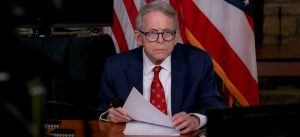News
Gov. DeWine Sets Benchmark For Lifting Ohio’s Public Health Orders
By: Gabe Rosenberg | WOSU
Posted on:
COLUMBUS, Ohio (WOSU) — Gov. Mike DeWine gave his most confident signal yet that the end of the pandemic is close, declaring Thursday that he will lift all COVID-19 public health orders “when Ohio gets down to 50 cases per 100,000 people for two weeks.”

Although DeWine declared Ohio is “now on the offense with this virus,” residents aren’t likely to see restrictions disappear anytime soon. As of Wednesday, just one county – Holmes County, in Amish country northeast of Columbus – is below the 50-case threshold.
“The end of our fight is now in view, but we must continue pressing forward in these final days,” DeWine said. “We want all Ohioans to complete this vital mission together.”
While some Republicans point to Texas and Mississippi, which lifted their mask mandates and business capacity limits this week, Ohio will not yet drop its requirement for face masks in public places – which has been in place since July.
Calling them a “battle-tested tool,” DeWine again emphasized how effective face masks have been at preventing the spread of disease in schools, even when kids are less than six feet apart and in the same room for prolonged amounts of time.
Ohio did recently ease some of its restrictions, reopening sports and entertainment venues at 25% of indoor capacity and 30% of outdoor capacity, and allowing banquet halls to host larger events again. DeWine said he looks forward to a spring of proms and weddings, and a summer of festivals, fairs and baseball.
Meanwhile, the state’s ban on “mass gatherings” over 10 people – a restriction first implemented last March – remains in place.
DeWine praised Ohioans for the sacrifices they’ve made in the last year to combat the virus.
“Our communities have come together,” DeWine said. “We’ve done things the Ohio way. We’ve been careful. And we’ve been caring.”
All told, about 17,000 Ohioans have died from COVID-19 so far. However, death totals have not been updated in several days after the health department changed its reporting system.
“We Must Fight Until The Very End”
DeWine’s address came nearly a year to the day of his first major action related to the pandemic. On March 3, 2020, DeWine – alongside Mayor Andrew Ginther and then-Health Department Director Amy Acton – laid down strict attendance limits on the annual Arnold Sports Festival in Columbus and canceled the popular Fitness Expo.
The decision to curtail the giant sports festival, which typically attracts 20,000 athletes from 80 countries and thousands of spectators, came before Ohio reported a single case of COVID-19 but turned out to be a harbinger of what was to come.
Nine days later, DeWine ordered schools closed for three weeks, a move that ultimately ended in-person learning for many districts for nearly a year.
“None of us then fully understood the battle ahead,” DeWine said of last March. “This has been a tough year.”
This past Monday, March 1, was the state’s deadline for school districts to resume at least partial in-person learning, in exchange for staff and teachers receiving the COVID-19 vaccine. DeWine said that effort proved successful.
“We’ve vaccinated over 200,000 educators in just four weeks in February,” DeWine said. “And today, nearly 95% of our children are back in school, in person, learning. We had a plan, and we carried it out.”
Now in the second phase of its vaccine rollout, Ohio has seen hospitalizations and other key numbers fall to their lowest levels in half a year. The Ohio Department of Health reported 1,875 new cases in the last day, along with 82 hospitalizations and seven ICU admissions.
DeWine said that nursing homes in particular have seen coronavirus cases drop 90% since December – from over 2,800 cases per week down to 268. Nursing homes, where a majority of the Ohio’s COVID-19 deaths have occured, were a top priority for vaccinations.
More than 1.8 million people in Ohio have received at least one shot of the vaccine as of Thursday, or about 15% of the population. More than 984,000 have completed their vaccinations, or about 8% of the population.
Even with vaccine supplies increasing, DeWine warns the virus continues to morph into a more contagious disease, and that the next few months remain unpredictable. And as he’s done in all his primetime addresses, the governor urged residents not to let up on precautions just yet.
“All of us are so sick of this virus,” DeWine acknowledged. “But you know, we must resist this urge, and we must fight until the very end.”

